|
March 22, 2021
Media Contact: Kristina Wieghmink, public information officer
kwieghmink@miottawa.org I mobile/text 616-510-8523
Additional COVID-19 variant B.1.1.7. cases identified in Ottawa County
The Michigan Department of Health and Human Services (MDHHS) notified the Ottawa County Department of Public Health (OCDPH) that the MDHHS Bureau of Laboratories identified the COVID-19 variant known as SARS-CoV-2 B.1.1.7 in two additional Ottawa County residents. One of the confirmed cases is younger than 20 years of age and the other in their 20s - both had no known travel history.
"We are encouraging everyone who may have been exposed to COVID-19, or have symptoms of the disease, to please seek out testing," said Marcia Mansaray, OCDPH deputy health officer. "Testing is more important than ever. If we can't find the virus, we can't stop it!"
The SARS-CoV-2 B.1.1.7 variant is thought to have emerged in the United Kingdom and has since been detected in many countries and states. This variant is concerning because it is associated with increased transmissibility. Compared to the wild-type virus, the B.1.1.7 variant is approximately 50 percent more transmissible, leading to faster spread of the virus and potentially increasing numbers of cases, hospitalizations and deaths. Centers for Disease Control and Prevention variant data.
Public health is working to minimize the known serious consequences of COVID-19 infections, as well as the overall impacts on limited healthcare resources. With the high rate of transmissibility of the B.1.1.7 variant, vaccination is more important than ever. People should get vaccinated as soon as it is offered to them. At this time, the COVID-19 vaccines appear to be effective against the new variant. The protective actions that prevent the spread of COVID-19 will also prevent the spread of the new variant B.1.1.7.
Public health mitigation measures aimed to minimize the impact of this variant strain in our communities include the following recommendations:
- Wear a face mask around others
- Keep at least 6 feet apart from others
- Clean hands and disinfect surfaces frequently
- Avoid crowded areas or gatherings
- Ventilate indoor spaces if around others
- Avoid domestic and international travel
- Limit interactions with people who live outside of your household
-
Seek testing if ill, exposed or after travel
- Follow isolation or quarantine guidance if ill, exposed, or waiting on test results
- Get vaccinated when the vaccine becomes available to you
LEARN MORE
Wondering if it's COVID-19 or just allergies?
Check out this chart to learn the differences. When in doubt, get tested for COVID-19!

|